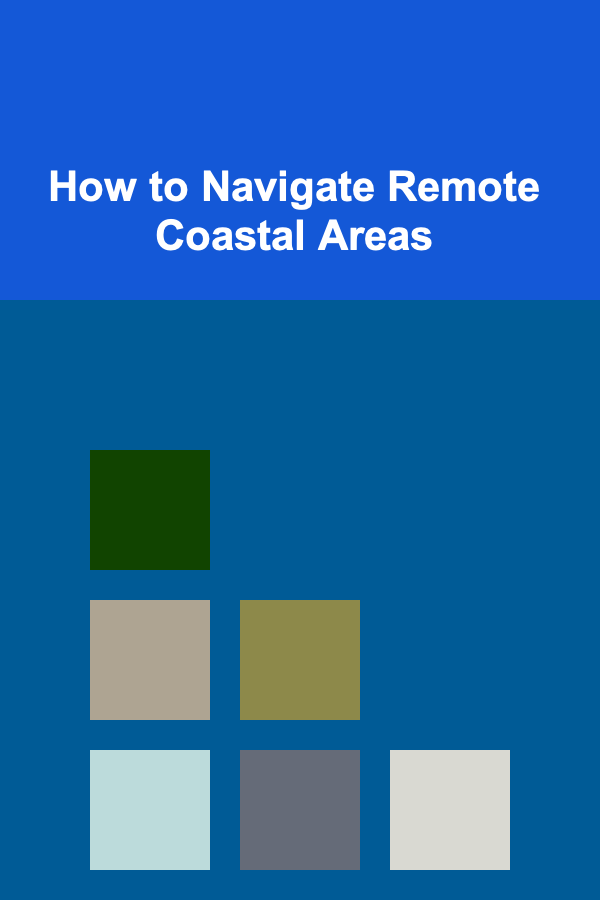
How to Navigate Remote Coastal Areas
ebook include PDF & Audio bundle (Micro Guide)
$12.99$9.99
Limited Time Offer! Order within the next:

Coastal areas, particularly those in remote locations, are both captivating and challenging environments for travelers, explorers, and professionals alike. These areas, often characterized by their rugged landscapes, unpredictable weather, and lack of modern infrastructure, require specialized knowledge and preparation to navigate safely and efficiently. Whether you're planning a kayaking expedition, conducting field research, or simply exploring the wilderness, understanding how to navigate remote coastal areas is essential to ensure both safety and success.
In this article, we will explore the necessary skills, techniques, and tools required to navigate coastal regions, covering everything from basic navigation principles to the unique challenges posed by remote coastal environments.
The Importance of Preparation
Before setting out on any journey into remote coastal areas, proper preparation is vital. These areas are often far from medical assistance, reliable communication, or other modern amenities. To ensure your safety, you should consider the following key aspects of preparation:
1. Research and Local Knowledge
Understanding the geography, weather patterns, tides, and local wildlife of the area is crucial. Remote coastal areas are typically less documented and may not have well-established routes or trails. Research local maps, tide charts, and weather forecasts, and speak to locals or experienced travelers who have navigated the area before.
Knowledge of local currents, potential hazards, and the best times to travel will help you avoid dangerous situations. Additionally, some coastal areas might be home to unique ecosystems or fragile wildlife, so learning about these factors will help you minimize your environmental impact.
2. Gear and Equipment
Remote coastal areas often lack facilities for basic needs, so you must bring everything you need for survival. Essential equipment includes:
- Navigation tools: GPS devices, compasses, and detailed maps specific to the area.
- Survival gear: A first aid kit, emergency shelter, fire-starting materials, and sufficient food and water supplies.
- Appropriate clothing: Layered clothing, waterproof gear, and footwear suitable for unpredictable conditions, such as rocks and muddy terrain.
- Watercraft (if applicable): If you're navigating by boat or kayak, ensure your vessel is well-equipped with safety equipment like life jackets, flares, and signaling devices.
Having reliable gear and understanding its proper use is crucial, as equipment failure could leave you stranded in difficult conditions.
3. Physical and Mental Fitness
Remote coastal navigation can be physically demanding, requiring endurance, balance, and the ability to adapt to varying environmental conditions. Coastal terrain can range from sandy beaches to rocky outcroppings and dense vegetation. These elements, combined with fluctuating tides, unpredictable weather, and isolation, can put a significant strain on your body and mind.
Staying in good physical shape is essential for handling the physical demands of the journey. Mental resilience is just as important, as the isolation and potential challenges of the journey can lead to stress or anxiety. Being prepared for the mental aspects of remote navigation will help you stay focused and calm in stressful situations.
Understanding Coastal Navigation
Navigating coastal areas involves not just finding your way, but also dealing with the unique challenges posed by tides, currents, and constantly changing weather conditions. Here are some of the primary considerations to keep in mind.
1. Tides and Currents
Tides play a critical role in navigating coastal regions, especially when dealing with rivers, inlets, or shallow bays. Understanding tidal movements is essential for several reasons:
- Tidal Schedules: Tides rise and fall predictably, but the timing varies depending on the location. Access to certain areas may be possible only during low tide, while others may become dangerous or impassable during high tide. Make sure to consult tide charts for the area before planning your journey.
- Currents: Coastal areas often have strong tidal currents that can quickly alter the speed and direction of your travel, whether you're walking along the shore or kayaking. These currents can either aid your progress or hinder it, so it's essential to understand how they operate.
- Shallow Water Hazards: Some coastal areas may be impassable during high tide or dangerous due to submerged rocks and sandbars. At low tide, these obstacles may become more visible and navigable. Always check the tides and plan your movements accordingly.
2. Weather and Microclimates
The weather in coastal regions can change rapidly, and many remote coastal areas are subject to frequent storms, fog, and temperature fluctuations. Unlike inland areas, coastal weather can be influenced by various factors, including the proximity of large bodies of water, wind patterns, and even the surrounding topography.
For example, coastal areas in the northern hemisphere often experience cooler and wetter conditions due to ocean currents and atmospheric circulation. Conversely, tropical coastal areas may experience intense heat and frequent rain showers. Understanding these microclimates can help you prepare better for the conditions you'll face.
Always monitor local weather forecasts and be prepared for sudden changes. Bring weather-resistant clothing, and consider packing extra layers to stay warm during unexpected cool spells. When venturing into particularly remote areas, it may also be wise to have access to satellite weather updates, which can provide real-time information about storm developments.
3. Navigation by Land and Sea
Navigating by land and sea in remote coastal areas presents different challenges. Whether you're on foot, on a bike, or using a boat, the need for careful planning is crucial.
- Land Navigation: On foot, coastal terrain can be rugged and difficult to traverse. Beaches might be sandy and soft, while rocky outcroppings could require careful climbing. Vegetation may limit visibility, and overgrowth can obstruct trails. In such terrain, a map and compass are your best tools, especially when the terrain is not well marked.
- Sea Navigation: When traveling by boat or kayak, navigating coastal waters requires a solid understanding of marine navigation. Use a marine chart for precise mapping of the coastline and to identify hazards like submerged rocks or reefs. In addition, be aware of maritime traffic and follow all maritime regulations in the area.
Always use a combination of tools for accurate navigation: GPS for real-time tracking, compass and map for traditional navigation, and local knowledge to account for any irregularities that technology may miss.
Managing Safety in Remote Coastal Areas
Remote coastal regions often lack modern safety infrastructure like hospitals, rescue services, or public facilities. As such, managing safety while navigating these areas requires additional precautions.
1. Communication and Emergency Preparedness
Before embarking on a journey into a remote coastal area, ensure you have reliable communication tools. While cell phones might not work in these locations, satellite phones and emergency beacon systems (such as a Personal Locator Beacon or Satellite Messenger) are invaluable for sending distress signals if needed.
Establish an emergency plan with friends or family, providing them with your itinerary and expected return time. Check in regularly if possible, and always have an emergency contact who can alert authorities if you fail to return.
2. Hazard Identification
Identifying potential hazards is another critical component of navigating remote coastal areas. These can include:
- Wildlife: Coastal areas may be home to potentially dangerous wildlife, such as bears, venomous snakes, or even sharks. Familiarize yourself with the animals of the area and take appropriate precautions.
- Tidal Surges: Sudden tidal surges or strong waves can easily overwhelm an unprepared traveler. Always be aware of the time, location, and speed of tide changes in areas where you are traveling.
- Rocks and Slippery Surfaces: Coastal terrain can be hazardous due to rocks, tidal pools, and seaweed-covered surfaces. Sturdy footwear and caution are key when walking along cliffs or rocky shorelines.
3. Survival Skills
In remote coastal areas, having basic survival skills is essential. Learn techniques for building shelters, starting fires, purifying water, and preparing food. Coastal areas often provide ample resources such as edible plants, fish, and seaweed, but knowledge of what is safe to consume is crucial.
Learn how to perform basic first aid, as you may not have access to medical professionals. Training in CPR, wound care, and recognizing signs of dehydration or hypothermia could make a life-saving difference in an emergency.
Conclusion
Navigating remote coastal areas is an exciting challenge that demands both skill and preparation. With the right knowledge, equipment, and mindset, these coastal environments can offer unparalleled beauty and adventure. Understanding tidal patterns, weather shifts, navigation tools, and potential hazards is key to safely and effectively exploring these wild and often isolated regions.
Whether you're journeying by land or sea, preparation is the foundation of success. With proper research, the right gear, and the right mindset, you can confidently navigate remote coastal areas, ensuring both a safe journey and an unforgettable experience in the natural world.

How to Create a Checklist for Leveraging User-Generated Content in Email Campaigns
Read More
How to Help Students with Video Production for Business or Marketing
Read More
How to Make Money Online as a WordPress Developer: 10 Actionable Ideas
Read More
How To Research Crypto Lending Platforms and Their Risks
Read More
Discovering Family-Friendly TV Shows Everyone Will Love
Read More
10 Tips for Bowling with Kids: Fun and Skill Development
Read MoreOther Products

How to Create a Checklist for Leveraging User-Generated Content in Email Campaigns
Read More
How to Help Students with Video Production for Business or Marketing
Read More
How to Make Money Online as a WordPress Developer: 10 Actionable Ideas
Read More
How To Research Crypto Lending Platforms and Their Risks
Read More
Discovering Family-Friendly TV Shows Everyone Will Love
Read More